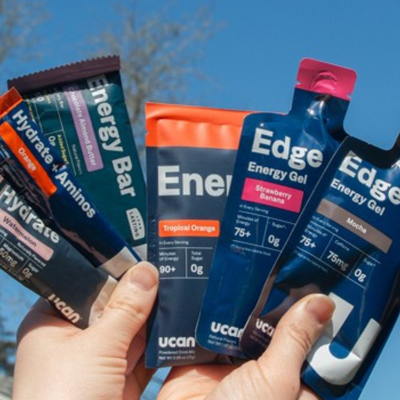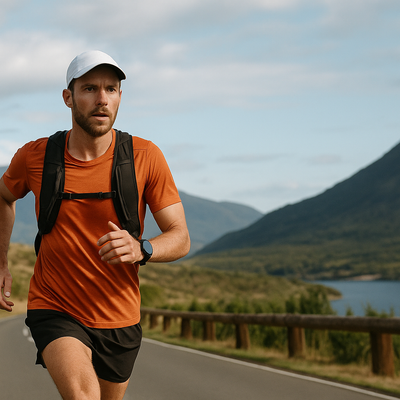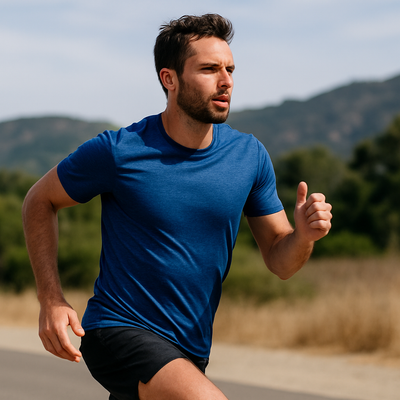When it comes to marathon training, most runners focus on the running itself but fail to also focus on the fuel that your body needs to perform and recover. Without the right marathon nutrition plan, your engine is running on empty, your body won’t have the building blocks it needs to adapt, and you won’t hit your goals. Our Marathon Fueling Guide will help you nail your nutrition, give you tips on how to fuel with UCAN, and teach you to avoid the pitfalls that many runners fall into.
Why You Need to Fuel for Marathon Training
Many runners start out running HS Track or local 5k road races where nutrition during your runs isn’t necessary. You can get away with poor nutrition habits at shorter distances. Once they move up to longer distances, the errors in their nutrition approach are revealed, often resulting in the dreaded bonk (aka hitting the wall). Running longer runs and marathons without fuel means energy levels, and blood sugar levels, fade over time. You feel worse and worse until glycogen (carbohydrate) stores are all but depleted and you’re forced to walk. There is no more ‘faking it’ when it comes to your nutrition approach when you get up to the marathon distance since glycogen stores are limited at around 2000 calories, or about 2-2.5 hours. Most first-time marathon runners will be out there for at least 4 hours, so fueling before and during your run is critical to performing your best and feeling good doing it.
How Carbohydrates Give Marathon Runners Energy
Carbohydrates are the main source of fuel for endurance athletes in training. The performance benefits of carbohydrates were discovered many decades ago and since the 1970s, fast-acting carbs like simple sugars (i.e. fructose and glucose) and maltodextrin have been used in a big way by sports nutrition companies to fuel runners. Consuming these carbohydrates boosts blood glucose and energy levels rapidly, but there’s a downside - the subsequent crash. This crash occurs because the body senses rising blood sugar levels, and the pancreas releases a hormone called insulin, which draws sugar out of the blood stream. To avoid this crash, sports nutrition companies recommend re-dosing about every 30 minutes with a sugar-based energy gel, or to continuously sip at a sugary sports drink. This is essentially to try to get you to stabilize energy and blood sugar levels. But there’s a catch – you can’t have too many simple carbs at once or you’ll be at risk for GI distress and overly high blood sugar levels, and you can’t take too little or you’ll bonk. Most traditional sports nutrition with simple carbs provide a spike and crash effect, and you’re left managing the “sugary roller coaster.” If you have a misstep in your fueling protocol, then you might end up running out of energy or hitting the wall.

The Challenges of Fueling for Marathons
Stomach issues or GI distress is one of the most common challenges faced by marathon runners. If you’ve ever experienced GI distress (sloshing, bloating, nausea, vomiting, diarrhea) then you know it can make for a miserable training or race experience and can be deadly to your performance. Runners often skip fueling because they can’t figure out when to eat or what to eat in order to feel good throughout a workout.
“For years, I watched well-trained runners fail because of the nasty effects of sugary gels and chews,” says Coach Greg McMillan, who’s worked with all levels of runners from Olympians to first time marathoners. “From the stomach upset to the spike and crash of energy, the athletes were being robbed of great performances simply due to a lack of perfect nutrition.”
When it comes to how easy or harsh sports nutrition is on your stomach, osmolality plays a big role. Osmolality is a term describing how quickly a solution clears your stomach and enters the gut. Traditional energy gels and sports drinks with maltodextrin and simple sugars have a high osmolality, which is why many runners experience GI distress when they consume them repeatedly.
“High osmolality means that there are lots and lots of small molecules in a given space, and each one of them needs to be transported (by water molecules) through the stomach barrier and into the gut,” says Bob Seebohar, former U.S. Olympic sports dietitian and founder of eNRG Performance. “Since this process takes time and requires lots of water, it means fluids can slosh around in the stomach for a while, potentially causing problems.”

The UCAN Difference
The energy source that powers UCAN energy products is called LIVSTEADY™, a low glycemic, complex carbohydrate that breaks down at a steady rate over time, almost like a time-released source of energy. This is the key ingredient in UCAN products and what sets it apart from other fuel sources. It provides energy for several hours after you consume it, which has been demonstrated in several studies, including one from 2019 that showed energy still being released after 3 hours of running.
With LIVSTEADY, you don’t get the spike & crash in blood sugar and energy that you do from fueling with simple carbs. The energy release is so prolonged, in fact, that it massively improved the lives of children with a rare metabolic disorder, the initial reason for UCAN’s existence.
A large portion of UCAN’s running customers come to UCAN because of this steady feeling of long-lasting, strong performance without sugar. LIVSTEADY also has a very low osmolality, meaning it exits the stomach quickly and does not require lots of water to digest. This makes it a stomach-friendly solution for runners who are struggling to take in sugary sports fuels. “UCAN takes the worries out of running,” says Coach McMillan. “It keeps your blood sugar stable, helps you burn more fat, and spare carbohydrates, which is the trifecta to avoid the bonk. I finally feel like I’ve solved the fueling puzzle for my runners.”
How to Fuel with UCAN for Marathon Training
UCAN simplifies marathon nutrition for runners. You’ll be able to fuel at less frequent intervals and won’t be prone to rapid energy swings if you don’t get the timing exactly right. Here’s how to use UCAN in your training.
Pre-Run Energy
Fueling up with UCAN before a workout is one of the best times to use the product. When you have simple carbs before your run, you may start to feel your blood sugar drop 30 minutes into your workout, which can cause fatigue and loss of focus. Using UCAN pre-run is the best way to ensure you have steady energy throughout.
Here are some tips to get started:
- Fuel with UCAN Energy Powder or Edge energy gel 30 minutes before your run
- 1 serving of Energy Powder has 20g of LIVSTEADY carbs and delivers 60-90 minutes of steady energy; 1 serving of Edge has 15g LIVSTEADY and delivers 45-60 minutes of steady energy.
- Load up with multiple servings of UCAN pre-workout if you’re training for over 90 minutes and want a longer burn of energy.
During Run Energy
Here are some tips on fueling with UCAN during a workout:
- Consume 1 serving Edge every 45-60 minutes during exercise. Adjust up or down based on your energy needs. Edge won’t give you a sugar rush like a typical energy gel, and you don’t need to chase it with water to digest it.
- You can also fuel with the Energy Powder during your runs if you prefer it to Edge. Start with 1 serving per hour. Try taking big gulps at once and consuming a substantial amount each time so you finish a serving over the course of a mile. UCAN works best when you consume an entire serving over a short period of time and allow it to steadily release into your body vs. sipping on it slowly.
- You can concentrate the Energy Powder with 4-6 oz. water and mix it into a small flask or carry multiple servings in a bottle
- Try to minimize the amount of sugar or simple carbs you consume along with UCAN, but having small amounts of sugar during exercise in conjunction with UCAN will not negate the impact. If you’re taking in sugary sports nutrition, do it later in the workout.
Recovery Nutrition
Refueling with Protein + Energy after a tough session helps your muscles recover while giving you a consistent release of energy so you don’t crash. “It’s a slower energy burn so that's going to keep you satiated longer, for at least a couple hours,” says Seebohar. Consume 1 serving Energy + Protein within 30 minutes after a long run or hard workout. 1 serving contains 15g LIVSTEADY carbs and 20g of protein (both whey protein and pea protein options are available).
It's important to recover with carbs and protein for endurance athletes in order to replenish glycogen, especially after a long run. For athletes with body composition and weight loss goals, a recovery drink with steady-release carbs instead of sugar will keep the body in fat-burning mode for longer post workout and can also help curb post-run hunger.
Looking for more recovery tips?
Learn more about recovery nutrition for runners here.

Practice your Race Fueling in Training
Dialing in your nutrition approach takes time since trial and error is the most effective way to arrive at a nutrition approach that works for you. “We are all individuals and respond differently to the foods we put in our body, so no article or expert can tell you what your perfect nutrition plan is right from the start,” shares Seebohar.
Some questions you might ask yourself, and test in training, to dial in your UCAN usage:
- Do I perform best on 1 serving per hour of UCAN, 2 per hour, or something in between?
- Should I “pre-load” with 2 or 3 servings of UCAN Energy before a long run or race?
- Will I eat a meal on race morning or will my lack of appetite and nerves prevent me from doing so? Consider 1-2 servings of Protein + Energy instead.
- Do I prefer using Edge (gel), Energy Powder (fluids) or Energy Bars (solids) to fuel my performance?
- What’s my strategy for carrying my UCAN on course? Have I dialed in my preferred quantities and do I own what I need to easily transport my UCAN?
You should use the nutrition that you plan to race with for your training as well for the following reasons:
- To gather a stronger understanding over time of how much you need so that you are optimally fueled on race day, without hitting the wall or having stomach problems.
- You will discover whether you prefer fluids or solids or a combination.
- Your gut is “trainable” and will get used to what you put into it regularly. Nothing new on race day.
- You can practice various methods of carrying and consuming your nutrition so that on race day you are not burdened with anything more than the physical goal you’ve set for yourself.
All of these reasons are best covered during a “race simulation” day where your intensity level and length of workout is as comparable as possible to what you will actually do on race day. That will tease out any flaws in your nutrition approach since you’re subjecting yourself to as much of the race day stress as possible. That said, no coach will recommend running a marathon at marathon pace prior to the marathon. You might decide, or be coached, to instead run a 20 mile long run with two 6-mile marathon-paced segments included as your race simulation. That effort will help you work out the kinks and give you rock solid confidence that your race day nutrition will be spot on.
Nailing your nutrition is a key aspect of marathon training and racing. Prioritizing the fuel you put into your body will have you on track for your best marathon training block yet, and you’ll be well on your way to crushing your goals.









